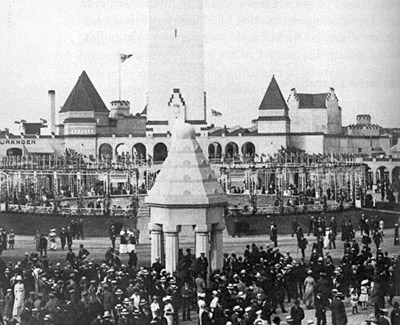| Introduktion

| | Perioden 1900-1940 er den periode, hvor industrisamfundet og det parlamentariske systems spilleregler for alvor sætter sig igennem.
Udviklingen af ny transport - og kommunikationsteknologi skabte nye samarbejdsmuligheder i Øresundsregionen
|
Perioden 1900-1940 er den periode, hvor industrisamfundet og det parlamentariske systems spilleregler for alvor sætter sig igennem. Udviklingen af ny transport - og kommunikationsteknologi skabte nye samarbejdsmuligheder i Øresundsregionen og den hastigt voksende industriarbejderklasse krævede, via hårde arbejdskampe, indflydelse på udviklingen. I mellemkrigstiden blev et vigtigt resultat af disse magtkampe socialdemokratiske statsministre og borgmestre i både Danmark og Sverige.
Man havde i begyndelsen af århundredet den opfattelse, at datidens lande omkring Østersøen, det vil sige Tyskland, Danmark, Sverige og Rusland, naturligt hørte sammen. På utallige måder forsøgte man at manifestere dette. Bl.a. ved en række store fælles industri og kulturudstillinger i Øresundsregionen, hvor landene præsenterede deres industrielle og kulturelle fremskridt.
Ved 1ste Verdenskrigs udbrud i 1914 brød disse bestræbelser sammen, fordi Tyskland og Rusland stod på hver sin side i dette opgør.
Sverige og Danmark førte krigen igennem en neutralitetspolitik, men blev presset af både England og Tyskland. Det var især adgangen til Østersøen, gennem de danske bælter og Øresund, kampen stod om, og begge lande blev, af Tyskland, tvunget til at minere farvandene, så England ikke kunne trænge ind i Østersøen.
I mellemkrigstiden, (1918 – 1940) udvikledes stadigvæk nye og mere effektive samfærdselsmidler over Sundet. Færgeoverfarternes kapacitet og antal blev udvidet og forøget, og med opfindelsen af flyvemaskinen kunne både svenske og danske flypionerere fra 1910 flyve over Sundet.
Samarbejdet mellem Helsingør og Helsingborg blev under den verdensomspændende økonomiske krise i 1930’erne styrket af, at den svenske industrifyrste, Dunker, i 1935 etablerede en af sine gummifabrikker, Tretorn, i Helsingør. Med sine ca. 1000 arbejdere blev det, næst efter Helsingør Skibsværft, byens største arbejdsplads.
Med sine mange industriarbejdere blev Helsingør en stærk socialdemokratisk bastion i Danmark, hvor byens socialdemokratiske borgmester fra 1919, Peder Christensen, i mange år stod i spidsen for en slags socialdemokratisk ”kommune-socialisme”. Det betød bl.a. et omfattende kommunalt støttet boligbyggeri og etablering af en række kooperative virksomheder.
Den eksplosive industrielle og kulturelle udvikling kan, især, i Helsingborg, iagttages i byens arkitektur. En tur gennem byen viser eksempler på historicisme, hele villakavarterer i jugendstil og 1930ernes funktionalisme i offentlige bygninger.
I Helsingør er der også eksempler på dette, men hér har man i bykernen valgt at værne om 1700-tallets bystruktur og arkitektur. |